
HMS Amazon was the first Type 21 frigate of the Royal Navy. Her keel was laid down at the Vosper Thornycroft shipyard in Southampton, England. The ship suffered a fire in the Far East in 1977, drawing attention to the risk of building warships with aluminium superstructure.
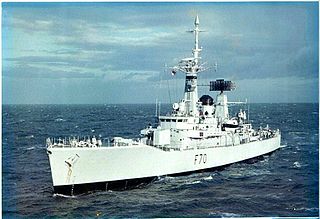
The Leander-class, or Type 12I (Improved) frigates, comprising twenty-six vessels, was among the most numerous and long-lived classes of frigate in the Royal Navy's modern history. The class was built in three batches between 1959 and 1973. It had an unusually high public profile, due to the popular BBC television drama series Warship. The Leander silhouette became synonymous with the Royal Navy through the 1960s until the 1980s.

The Battle class were a class of destroyers of the British Royal Navy (RN) and Royal Australian Navy (RAN), named after naval or other battles fought by British or English forces. Built in three groups, the first group were ordered under the 1942 naval estimates. A modified second and third group, together with two ships of an extended design were planned for the 1943 and 1944 estimates. Most of these ships were cancelled when it became apparent that the war was being won and the ships would not be required, although two ships of the third group, ordered for the RAN, were not cancelled and were subsequently completed in Australia.

HMS Achilles was a Leander-class frigate of the Royal Navy. She was built by Yarrow at Glasgow. She was launched on 21 November 1968 and commissioned on 9 July 1970. She was sold to Chile in 1991 and served in the Chilean Navy as Ministro Zenteno. She was washed away from her berth at Talcahuano by a tsunami following the February 2010 Chile earthquake, and ran aground on the coast a few kilometres to the north. She was scuttled the following month by the Chilean Navy as a danger to navigation.

HMS Cleopatra (F28) was a Leander-class frigate of the Royal Navy (RN). Cleopatra was built at HMNB Devonport. She was launched on 21 March 1964, commissioned on 1 March 1966 and decommissioned on 31 January 1992.

HMS Apollo was a batch 3B broadbeam Leander-class frigate of the Royal Navy. She was, like the rest of the class, named after a figure of mythology. Apollo was built by Yarrow Shipbuilders of Scotstoun. She was launched on 15 October 1970 and commissioned on 28 May 1972, making her the penultimate Leander.
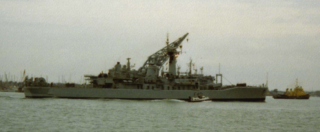
HMS Sirius (F40) was a Leander-class frigate of the Royal Navy (RN) built by H.M. Dockyard Portsmouth, and was the penultimate RN warship to be built there for a period of forty years, until Vosper Thornycroft built HMS Clyde. Sirius was launched on 22 September 1964 and commissioned on 15 June 1966. The ship continued in front line service until February 1992.

HMS Barrosa (D68) was a later or 1943 Battle-class fleet destroyer of the Royal Navy.

HMS Yarmouth was the first modified Type 12 frigate of the Rothesay class to enter service with the Royal Navy.
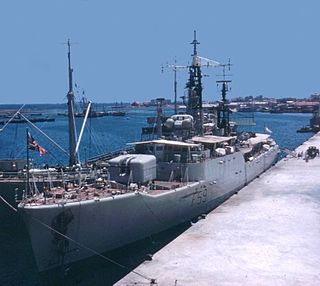
HMS Chichester was a Salisbury-class or Type 61 aircraft direction frigate of the British Royal Navy.

HMS Torquay was a Type 12 Whitby-class frigate of the British Royal Navy. They were the first frigates to have the "V" form hull. This evolutionary design made it possible to be driven in head sea without the usual slamming which occurs with conventional destroyers of the time. Each frigate cost 3.5 million pounds and the first ship completed was Torquay in May 1956.

HMS Keppel (F85) was one of a dozen Blackwood-class frigate of second-rate anti-submarine frigates built for the Royal Navy in the 1950s. She was named for Augustus Keppel, who served during the Seven Years' War and was admiral of the Western Squadron during the American War of Independence.

HMS Lowestoft was a Rothesay-class or Type 12M class anti-submarine frigate of the British Royal Navy. Lowestoft was reconstructed in the late 1960s to largely the same pattern as the third group of Leander-class frigates, with new radar and fire control and a hangar and pad for a Westland Wasp helicopter for longer range, anti-submarine, engagement. In the late 1970s it was converted as the prototype towed array frigate for the Royal Navy, but retained its full armament. Lowestoft was sunk as a target on 8 June 1986 by HMS Conqueror using a Tigerfish torpedo. She was the last Royal Naval target to be sunk still displaying her pennant number.
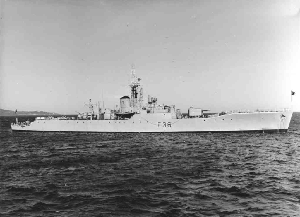
HMS Whitby was a Whitby-class or Type 12 anti-submarine frigate of the Royal Navy of the United Kingdom built by Cammell Laird and Co Ltd, Birkenhead. She was launched on 2 July 1954 and commissioned on 10 July 1956.

HMS Jaguar (F37), was a Leopard-class Type 41 anti-aircraft frigate of the British Royal Navy, named after the jaguar. Jaguar was the last frigate built by William Denny & Brothers for the Royal Navy. Unlike the rest of her class, she was fitted with controllable pitch propellers.

HMS Broadsword was a Weapon-class destroyer of the British Royal Navy in service from 1948 and scrapped in 1968.
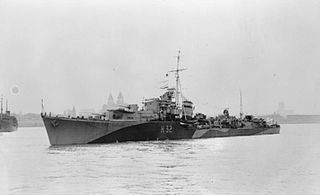
HMS Rapid was an R-class destroyer of the Royal Navy that saw service during the Second World War and was sunk as a target in 1981.

HMS Relentless was an R-class destroyer of the Royal Navy that saw service during World War II. She was later converted into a Type 15 fast anti-submarine frigate, with the new pennant number F185.

HMS Undaunted was a U-class destroyer of the British Royal Navy that saw service during World War II. She was later converted into a Type 15 fast anti-submarine frigate, with the new pennant number F53.
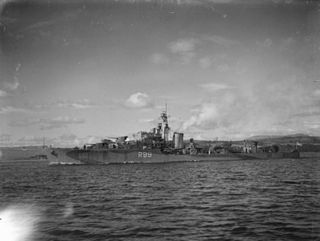
HMS Urchin was a U-class destroyer of the British Royal Navy that saw service during the Second World War.



















